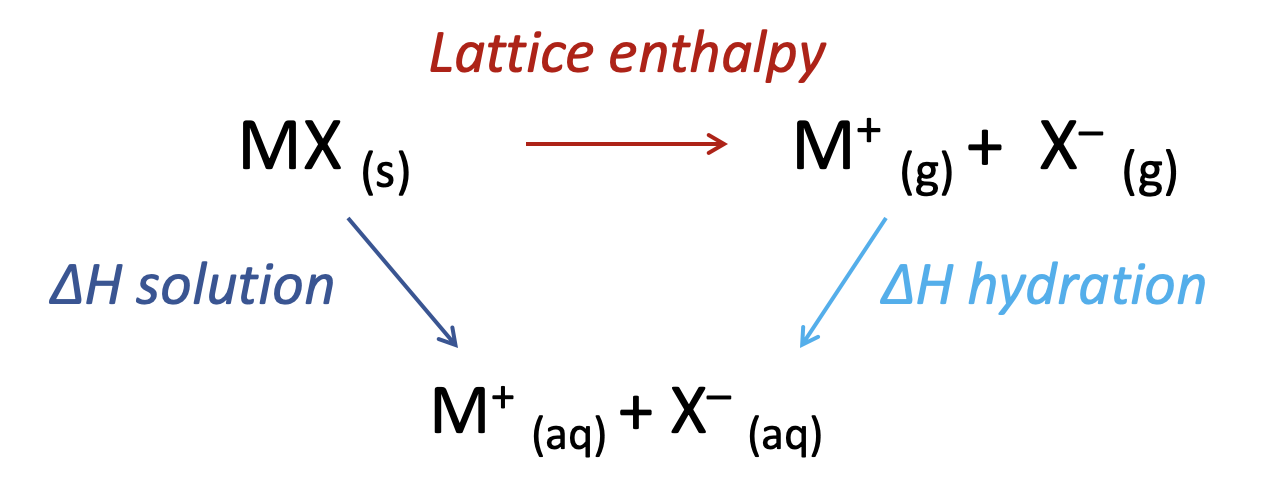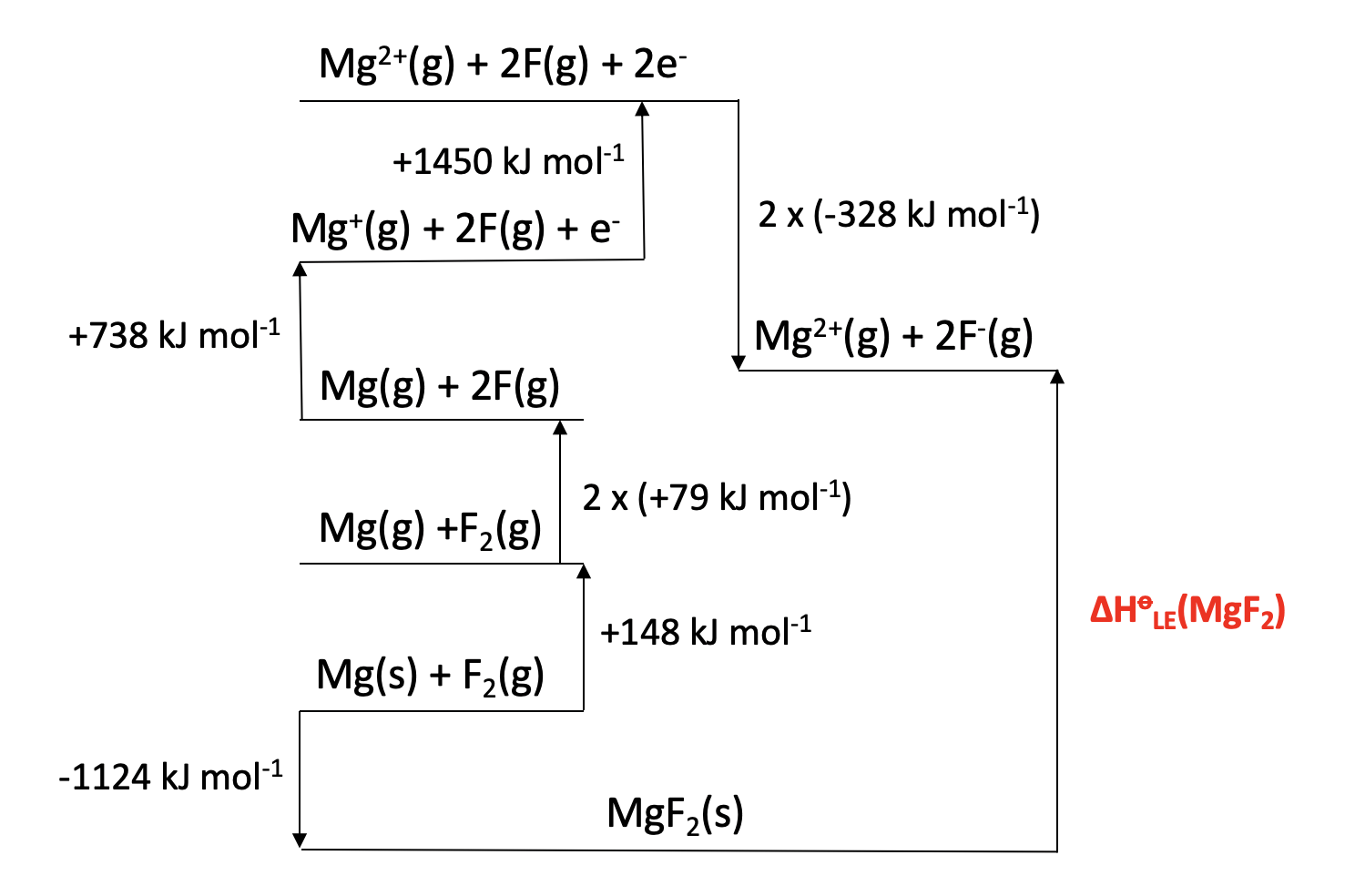Topics 15.1 and 15.2
Paper 1 style questions are multiple choice. You are not permitted to use a calculator or the data book for these questions, but you should use a periodic table.
A periodic table pop-up is available on the left hand menu.
Which reaction has the greatest increase in entropy of the system.
Gases tend to have greater entropy than liquids (or solutions), that tend to have greater entropy than solids. Any change that leads to a greater number of gaseous moles tends to lead to an increase in the entropy of the system.
Thus the correct answer here is 2NI3 (s) → N2 (g) + 3I2 (g), in which 2 moles of solid become 4 moles of gas.
What is the correct order of increasing (more exothermic) enthalpy change of hydration?
Xn+ (g) → Xn+ (aq)
Standard enthalpy of hydration is the enthalpy change when one mole of aqueous solution is formed from ions in the gaseous state.
Ions with smaller size and higher charge will have greater enthalpy of hydration values. Therefore in group 1; Li+ > Na+ > K+. And group 2 ions (like Be2+) will have significantly higher enthalpy values.
The correct answer (increasingly exothermic) is therefore K+, Na+, Li+, Be2+
Which is correct for this process?
H2O (l) → H2O (s)
This phase/state change involves the making of bonds, so the process in exothermic which means that the enthalpy change is negative - so enthalpy decreases.
Gases tend to have greater entropy than liquids (or solutions), that tend to have greater entropy than solids. Therefore entropy also decreases for this process.
The correct answer is Enthalpy decreases and entropy decreases
Which equation represents the standard enthalpy of atomisation of astatine, At2?
Standard enthalpy of atomisation is a definition that needs to be learned:
Standard enthalpy of atomisation is the enthalpy change when one mole of gaseous atoms is formed from the element in its standard state (at 100kPa and 298K).
Thus ½At2(s) → At(g) is the correct answer, since one mole of gaseous atoms are formed (from the element in its standard state).
Which equation represents lattice enthalpy?
Lattice enthalpy is a definition that needs to be learned:
Lattice enthalpy is the enthalpy change when one mole of an ionic compound in its standard state (solid) forms gaseous ions.
Thus KCl (s) → K+(g) + Cl−(g) is the correct answer.
What are the signs for ΔHo and ΔSo for this reaction which is spontaneous at low temperature and non-spontaneous at very high temperatures?
4Fe (s) + 3O2 (g) → 2Fe2O3 (s)
For a reaction to be thermodynamically spontaneous the change in Gibb's free energy (ΔG) must be equal to or less than zero.
ΔG = ΔH−TΔS (this should be learned)
(Note for explanation: |x| means magnitude of x, that is the numerical value of x without a sign. And remember that temperature, T in the expression is given in Kelvin (K) so is always positive.)
For the reaction to be become spontaneous at lower temperature, ΔH and ΔS would both need to be negative; then ΔG will be negative when |TΔS| < |ΔH|; this will occur as temperature decreases, as |TΔS| becomes smaller as temperature becomes smaller.
Therefore the correct answer is ΔHo is negative ; ΔSo is negative
Notes on incorrect answers
If ΔH is positive and ΔS is positive then ΔG will be negative when |TΔS| > |ΔH|; this will occur as temperature increases, as |TΔS| becomes greater as temperature becomes greater.
For the reaction to always be spontaneous (at any temperature), ΔH would need to be negative and ΔS would need to be positive; then ΔG will always be negative.
For the reaction to never be spontaneous (at any temperature), ΔH would need to be positive and ΔS would need to be negative; then ΔG will always be positive.
What is the enthalpy of solution for magnesium chloride, MgCl2 (s), in kJ mol−1?
| Enthalpy change | Value (kJ mol−1) | |
| Lattice enthalpy MgCl2 (s) | +2540 | |
| Enthalpy of hydration, Mg2+ (g) | −1963 | |
| Enthalpy of hydration, Cl− (g) | −359 |
It is worth learning the energy cycle (shown with a generic metal, M, and non-metal, X):

Following the alternative route, ΔH solution is therefore equal to lattice enthalpy plus ΔH hydration for the ions.
In MgCl2, there is one Mg2+ ion and two Cl− ions, so:
ΔH solution (MgCl2) = +2540 + (−1963) + 2(−359)
Which gives the correct answer 2540 − 1963 + 2(−359)
Which value represents the lattice enthalpy (in kJ mol−1) for magnesium fluoride, MgF2 as shown on the diagram?

Lattice enthalpy as shown on the diagram begins at MgF2 (s) and ends at Mg2+ (g) + 2F− (g), therefore we can take the alternative route beginning with going against the −1124 arrow and following around the energy cycle, inverting the signs of the energy changes when going against the arrows:
Thus, ΔHLE(MgF2) = −(−1124) + 148 + 2(79) + 738 + 1450 + 2(−328), which is therefore the correct answer.
Which statements are correct for ionic compounds?
1: Lattice enthalpy increases as ionic radii decrease.
2: Lattice enthalpy increases as the charge on the cation decreases.
3: Solubility in water depends on the relative magnitude of the lattice enthalpy compared to the hydration enthalpy
Lattice enthalpy increases with increasing charge of the ions and with decreasing size of the ions.
Solubility in water does depend on the relative magnitude of the lattice enthalpy and hydration enthalpy, as shown on the diagram below:

Therefore 1 and 3 only is the correct answer.
The combustion of ethanol is exothermic. Which is correct for this reaction?
C2H5OH (l) + 3O2 (g) → 2CO2 (g) + 3H2O (g)
The reaction is exothermic, so ΔH must be negative.
The reaction involves 1 mole of liquid and 3 moles of gas producing 5 moles of gas as written, so there must be a gain in entropy, since entropy increases gas>liquid>solid. Therefore ΔS must be positive.
For a reaction to be thermodynamically spontaneous the change in Gibb's free energy (ΔG) must be equal to or less than zero.
ΔG = ΔH−TΔS (this should be learned)
ΔH is negative and ΔS is positive, so ΔG will always be negative, since −TΔS will always be negative. Therefore the reaction will always be spontaneous (at any temperature).
ΔHo is negative ; ΔSo is positive ; the reaction is spontaneous is therefore the correct answer.
Consider the values of ΔHo and ΔSo for this reaction. Which statement is correct?
N2 (g) + 3H2 (g) → 2NH3 (g)
ΔHo = −92 kJ mol−1
ΔSo = −198 J K−1 mol−1
ΔG = ΔH−TΔS (this should be learned)
(Note for explanation: |x| means magnitude of x, that is the numerical value of x without a sign. And remember that temperature, T in the expression is given in Kelvin (K) so is always positive.)
If ΔH and ΔS are both negative; then ΔG will be negative when |TΔS| < |ΔH|; this will occur as temperature decreases, as |TΔS| becomes smaller as temperature becomes smaller.
Therefore the correct answer is ΔGo is negative at low temperatures
Notes
For a reaction to be thermodynamically spontaneous the change in Gibb's free energy (ΔG) must be equal to or less than zero.
If ΔH is positive and ΔS is positive then ΔG will be negative when |TΔS| > |ΔH|; this will occur as temperature increases, as |TΔS| becomes greater as temperature becomes greater.
If ΔH is negative and ΔS is positive; then ΔG will always be negative.
If ΔH is positive and ΔS is negative; then ΔG will always be positive.
Which equation represents the second electron affinity of sulfur?
First electron affinity and second electron affinity are definitions that need to be learned:
First electron affinity is the enthalpy change when one electron is gained by each atom in one mole of gaseous atoms.
Second electron affinity is the enthalpy change when one electron is gained by each 1− ion in one mole of gaseous ions.
Thus S−(g) + e− → S2−(g) is the correct answer.
How much of Energetics AHL (HL only) paper 1 questions have you understood?



 Twitter
Twitter  Facebook
Facebook  LinkedIn
LinkedIn